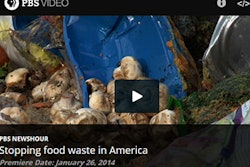| Lacey Quail, a South Dakota State University undergraduate research assistant, deposits mouse droppings from bedding into a test vial. The pathogen-free samples will be used to develop a new method of detecting salmonella in raw pet food. (Photo: Newswise) |
(Newswise) — Americans embrace their pets as members of the family and, in an effort to provide a healthy, natural diet, may opt to use raw pet food. However, they could be putting themselves and their children at risk for foodborne illnesses.
A Center for Veterinary Medicine study showed that 7.6 percent of the raw pet food tested contained salmonella, according to the Food and Drug Administration. But identifying the source of contamination — be it in raw materials or the manufacturing process — is difficult, according to South Dakota State University Senior Microbiologist Seema Das.
Through a five-year FDA grant for nearly $500,000, she will determine whether a test that detects salmonella in human food can do the same in raw pet food. The first year the test will be validated, and then either adjustments or expansion of the testing will be done in subsequent years. The work will involve multi-lab validation with collaborators at Iowa State, Texas A & M, the University of Minnesota and the New Jersey Department of Agriculture.
Protecting humans
“This is not only a pet health issue, it is a human health issue because everything is interlinked,” Das said.
When a pet owner handles the raw food, he must wash his hands carefully and thoroughly disinfect any surfaces the food touched, Das explained. If not, contamination may occur.
“If the pet food is contaminated with salmonella, it goes from the pet food to you,” she noted. That’s why the FDA has made this a priority.
The high number of product recalls over the last 10 years is cause for concern, according to national food safety manager Brenda Stahl of testing laboratory, EMS Analytical, Inc. In an article in Food Safety News, she points to manufacturing, rather than to raw ingredients, as being the culprit 90 percent of the time.
Detecting salmonella
After reviewing the recalls, Das and her research team suspect that mice or other rodents may be possible sources of contamination. Rodents and bugs can be problematic in factories where food is produced, Das explained. Salmonella is a common pathogen in mice.
The SDSU team, consisting of veterinarian Russ Daly, bacteriologist Laura Ruesch, microbiologists Marciel Aguiar and Cindy Watt and two undergraduate students, began working on the project in September.
The team has determined the lowest level of salmonella that the polymerase chain reaction, or PCR, system can detect in a sample. To do this, they took pathogen-free mouse droppings and spiked them with varying levels of salmonella, Das explained.
“We inoculate the mouse feces and then run the test,” she said. The PCR method can detect salmonella at dilutions as low as 15 colony-forming units per milliliter.
At each stage, PCR results are compared to those obtained through conventional bacterial culturing. The PCR test produces results within two to three days, while culturing takes four to five days.
The team will next examine specimens spiked with various amounts of salmonella including some that are just above the lowest detectable level and other samples with no salmonella. Das explained that 100 percent of the samples with salmonella at higher levels should test positive and all those without should be negative.
“This is the FDA requirement for validating a microbiological method,” she added. After the test has been validated in-house, Das will send trial samples to the other diagnostic labs.
Validating procedure
During the final stage of validation, the collaborating labs will not know which samples are positive or negative. Once the PCR method has been completed and verified with mouse feces, the researchers will move on to raw pet food as a test platform.
The FDA Level 3 validation involves five labs, Das explained; therefore, “you know the method works.”
Through this research project, the FDA will have a proven method to identify the source of the contamination when a recall occurs.
From a production standpoint, the testing procedure will minimize the economic impact on the company. In addition, the FDA will have a valuable tool with which scientists can deal with a threat to human health while also protecting the pet food supply.
About the Animal Disease Research and Diagnostic Lab
Since 1887, the South Dakota State University Animal Disease Research & Diagnostic Laboratory has served the public by providing high quality veterinary diagnostic services as a means to promptly and accurately establish causes of animal health problems. Such diagnoses aid attending veterinarians and health officials in the treatment, control, prevention and surveillance of animal diseases, benefiting South Dakota and national livestock industries, other animal owners and public health. Research work involves basic and applied investigations that enhance the understanding of the induction of diseases in animals, the development of diagnostic methods for the detection of diseased animals, products for treatment or prevention of disease and management protocols for the control of disease.





















